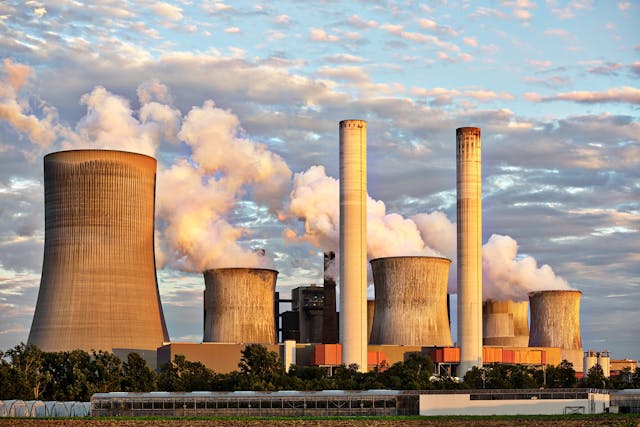
How can carbon be captured? There are many ways carbon can be captured when it is produced and then stored. However, it is much easier to stop carbon at source than it is to take carbon out of the atmosphere once it is already there. Let’s look at some methods to stop the carbon before it reaches the atmosphere and then some methods to remove it from the atmosphere.
Most of the carbon that is captured comes from places like power stations. A huge source of carbon dioxide is cars, trucks, planes, and trains, but it is very difficult to capture the carbon from each individual emitter. It is much easier, albeit still not very easy, to capture the carbon from a stationary place. Seeing as the burning of fossil fuels for power is the single largest producer of carbon dioxide, as in 87% of all emissions, it makes sense to start there. So, how is it done?
There are different ways, but the most common is to take the carbon out of the waste gases by using compounds called amines. The amino acids in our bodies are amines. In power stations, these amines are a combination of monoethanolamine, diglycolamine, diethanolamine, diisopropanolamine, and methyldiethanolamine. When fossil fuels are burned to make electricity, they release a number of gases, a large one of which is carbon dioxide. If the plant has no ability to capture the carbon, it is released into the atmosphere with all of the other gases. When a power plant is set up to capture carbon, the gases, which are 25% carbon dioxide, are kept from going into the atmosphere and they are redirected to a cooling tower to lower their temperature. When the gasses have been cooled down, they are piped to the carbon capture absorber, which contains some of the amine compounds I just mentioned. Amines contain nitrogen and that attracts the carbon in the carbon dioxide, pulling it our of the gasses. The gas is now clean of carbon dioxide and it is released into the air. The solution of amines and carbon dioxide goes to a stripper and it is heated to a high temperature, which separates the carbon dioxide from the amines and the amines go back to the absorber to be used again. That just leaves the carbon dioxide, which is a problem. It is compressed to form a liquid and then it has to be safely stored. Often it is buried in the underground spaces that have been created by removing the fossil fuels in the first place. That is a good solution, but some of the carbon dioxide does leak back out. The idea is that it will be absorbed into the porous rocks that are down there and kept out of harm’s way. The carbon dioxide is used to force more fossil fuels out of these holes to be burned for energy, and lot of people aren’t sure about the idea of using carbon dioxide to bring up more fossil fuels to burn and release even more carbon dioxide.
Carbon capturing from power stations has come a long way, but only about 0.1% of all the carbon dioxide produced every year is captured. That is a minuscule amount. Still, it is better than nothing, and the amount of carbon being captured is increasing every year. It is much easier and cheaper just to release it into the atmosphere, so a lot of legislation and tax incentives need to be put in place to make power companies do it. Obviously, the best type of carbon capture technology is to just leave the fossil fuels in the ground and make power with renewable energy, but that doesn’t look like it will happen soon.
How can you take carbon out of the atmosphere? The easiest way is to do it the way nature does. Carbon dioxide is absorbed by trees and plants, in soil, and in the sea. The trouble is you need an awful lot of trees to absorb the quantity of carbon dioxide we are producing. We tend to cut down trees faster than we plant them, and we are slowly reducing the amount of green biodiversity with our ever expanding cities. Soil is a good way to absorb carbon dioxide, but all of the soil we have we need to use to produce food, and a lot of those processes actually produce carbon dioxide. The sea will hold an enormous amount of carbon dioxide, but colder water holds more than warmer water, and as the temperature of the seas rise, they put out more carbon than they can absorb. There are some ideas to spread minerals that can absorb carbon dioxide on fields or use them to cover buildings, but that research is in its early days.
So, if we want to get the carbon out of the atmosphere, we are going to have to do it through technology. It would have to be similar to the technology that removes the carbon dioxide from the gasses produced by power stations, but the gas would not be captive, it is the whole atmosphere. There would have to be some way to get the air to go through giant machines that would use amines to pull the carbon dioxide out, and then the liquid carbon dioxide would have to be stored somewhere. This would be incredibly expensive and it would use enormous amounts of energy. If we are still making the energy by burning fossil fuels, it would be illogical because we would be putting out as much carbon dioxide as we removed. Whether it will be practical is still to be seen. The cost might be something we just have to live with. And this is what I learned today.
Try these:
Sources
https://www.wri.org/insights/6-ways-remove-carbon-pollution-sky
https://climate.mit.edu/explainers/carbon-capture
https://www.nationalgrid.com/stories/energy-explained/what-is-ccs-how-does-it-work
https://www.nytimes.com/interactive/2023/03/19/us/carbon-capture.html#
https://whatsyourimpact.org/greenhouse-gases/carbon-dioxide-emissions
https://climate.mit.edu/ask-mit/how-efficient-carbon-capture-and-storage
https://en.wikipedia.org/wiki/Amine
https://pubs.rsc.org/en/content/articlelanding/2021/sc/d0sc05625a
Photo by Pixabay: https://www.pexels.com/photo/landscape-photography-of-factory-459728/

Pingback: Did pirates really bury treasure?